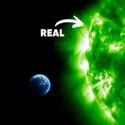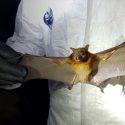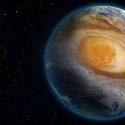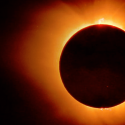12. THE SUN IS A GIANT BALL OF FIRE
Did you know that the Sun isn’t really on fire? No. Our Sun isn’t a raging bonfire in the center of the Solar System. It’s actually a nuclear reactor. Inside stars, hydrogen atoms fuse together to form helium atoms. And during that process of nuclear fusion, enormous amounts of energy are released. That energy shoots out in all directions, eventually making its way to you.
11. METEORS ARE FLAMING ROCKS
Let’s keep the heat on and take a closer look at some other seemingly fiery objects in our night sky. Meteors may look like they are on fire as they blaze their way through our atmosphere. But again that’s not exactly the case. If you’re lucky enough to catch a glimpse of a shooting star, what you’re really seeing is the glow from the intense air pressure in front of the meteor.
As it speeds through our atmosphere, the rapid compression of the air in front of the meteor heats things up until its glowing bright. And as a result of all that heat, meteors tend to burn up in our atmosphere even though they aren’t technically on fire.
10. NUKING AN ASTEROID IS A GOOD IDEA
Now, while our atmosphere is our last line of defense, unfortunately, some space rocks would just be too big for the atmosphere to consume before they crash into Earth. So, just like in the movies, if an giant asteroid were headed our way, we should probably nuke it, right?
Uh uh. No way. While nuking it could help to take a planet killing asteroid down a couple notches, it wouldn’t mean we’d be totally safe. If we nuked an asteroid, it would break into many smaller pieces. And any one, or hundreds of these could still pose a major hazard to life on Earth.
9. YOU CAN’T CRY IN SPACE
Hopefully talking about the terror of asteroids didn’t scare you too much. If so, wipe those tears from your eyes. Did you know that you can’t cry in space?
Well, sort of. You can cry as much as you feel like, but your teardrops won’t fall down your cheeks like they do here on Earth. Thanks to the microgravity in space, if you stubbed your toe on the International Space Station and started to bawl your eyes out, your tears would gather into a watery blob that would float or stick to the front of your face.
8. ZERO GRAVITY MEANS ZERO MASS
When you heard the word microgravity just now, you might have done a double take. Weren’t we always told there’s no gravity in space? And if there’s no gravity, then there must be no weight. Otherwise, how could astronauts just float around the ISS?
Well, the term zero gravity is misleading. There will always be some amount of force acting on an object. In the case of astronauts in the ISS, they aren’t actually weightless, they’re in a state of constant free-fall. Thanks to their orbit around Earth, they’re always falling but never landing.
7. THERE’S NO SOUND IN SPACE
In space, no one can hear you scream. You might remember that as the tag-line to the movie Alien. But, surprise, it’s only true to a point. While you’d never be able to hear spaceships exploding like you do in the movie, there are some areas in space where there may be enough particles to allow sound to travel. Like the hot gas clouds that surround some black holes. If there was enough gas, you might even catch a faint whisper of what a black hole sounds like.
6. PLANETS MAKE MUSIC
Speaking of sound, you may have heard the lie that planets all have their own song. This one has roots going back thousands of years to when ancient astronomers theorized about the “Music of the Spheres.” They thought that the movements of the planets might produce a form of music in itself.
Well, that didn’t exactly prove true. But the magnetic fields of the planets do interact with charged particles. And radio emissions that result from that interaction can be turned into sound waves. And don’t worry, scientists have already done that for you. But these eerie sounds aren’t exactly music to my ears.
5. ALL SPACE IS A VACUUM
OK, if we’re still making noise, it’d be a good time to talk about why there’s mostly no sound in space. That’s because space is a vacuum. But not completely. A vacuum occurs when matter is absent. No atoms, no molecules, no nothing.
Sure, space is pretty empty, but it’s not a perfect vacuum. There will always be a few stray atoms lurking in the gigantic voids between galaxies. OK, maybe having less than one atom for every cubic meter is really, really close to a vacuum. But still. It’s a lie.
4. ASTRONAUTS COULD EXPLODE IN SPACE
Thanks to movies and pop culture, another lie you’ve been fed is what happens when an astronaut is directly exposed to space without a spacesuit. If you’re out on a spacewalk and your suit or your helmet are breached, this would definitely be bad news. Space is harsh to the human body, and unless you could respond to the situation with lightning speed, you’d probably die. But rest assured, you wouldn’t spontaneously explode.
3. ASTRONAUTS CAN MOVE BY BLOWING AIR
While you’re floating around out there, we might as well tackle another misconception. But for this, we’ll need to change direction. Maybe try blowing air in one direction to see if that’ll move you? Nope. And believe me, it’s not just because you’ve got that helmet on your head. Even if you could exhale air forcefully, it wouldn’t be strong enough to budge you. That’s why staying attached to handrails or having thrusters on your suit is important to keep you close to where you want to be.
2. THE DARK SIDE OF THE MOON
Despite the legendary album by the rock band Pink Floyd, there isn’t actually a dark side of the Moon. At least not one that’s permanently dark. The reality is that the Moon is tidally locked to Earth. That means that the Moon takes the same amount of time to make one full spin on its axis as it does to revolve once around Earth. That means you only ever get to see sunlight hit one side of it. But every side of the Moon gets lit every day.
1. EARTH IS A PERFECT SPHERE
Alright. To wrap up this list of lies, let’s bring you all the way back home to planet Earth. From your vantage point out in space, this beautiful blue ball might have looked to be a perfect sphere. After all, that’s what you’ve been told your whole life.
But I bet you can guess what I’m going to say next. Yep, that’s another lie. Earth is technically an oblate spheroid. That means that it is slightly flattened on the north and south poles while it bulges out at the equator. How did it get this way? Well, imagine that when the planet was forming, it was a bit like a ball of clay. As it spins, the top and bottom get a bit squished down, while the middle looks more bloated.
OK, that’s enough space myths to debunk in one sitting. Did it make you wonder what other lies you’ve been told? How about some lies about the dinosaurs?



























